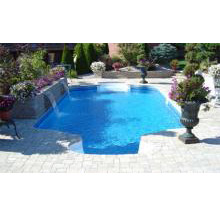How Long Does a Vinyl Liner Last in a Pool?

Everyone loves the look and feel of something new: the new car smell, the new carpet feel – and a new vinyl liner in an inground pool. The question on every owner’s mind is the same: how long is that look and my liner going to last? Many things come into the equation, but how well you manage your pool is the key factor.

Vinyl Liners: Myth & Reality
The standard image of the vinyl liner is of the one that goes into an above-ground pool. That is the image and myth we need to dispel when talking about vinyl liners for inground pools. Aboveground pool vinyl liners are traditionally made of thinner material and cut in a one-size-fits-all manner – regardless of the brand 24-foot round pool you purchase, you will get the same 24-foot round cut liner. These elements contribute to why the traditional above-ground pool liner has a relatively short lifespan. Vinyl inground pool liners, though, are “cut from a different vinyl”: they are made from more durable material and are cut to specification. This helps to ensure that your vinyl inground pool liner investment will last as long as you do your part.
Measure Twice, Cut Once – and Use Good Material
Whether it’s high fashion or vinyl inground pool liners, the end-product quality is all about the materials and the measurement.
Good Material
Although vinyl properties are relatively the same, what goes into the vinyl and the processing are not. In theory, where the raw materials are sourced – North America, South America, overseas – can play a role in liner longevity. Additionally, domestically sourced chemical additions (added to strengthen the vinyl) that are used within the actual liner tend to be stronger than those that come from external sources.
Good Measurements
Pools are like clothes: the better the cut, the better the fit – and without a good measurement, cutting policies are irrelevant. There are many manufacturers and manufacturing techniques – some companies have more stringent policies about the precision of their cutting. That is why it is critical that the manufacturer be provided with precise pool measurements: when the liner properly fits, there is less of a chance for loose or overstretched material, which, again, increases its look and longevity.
The Balancing Act of Pool Maintenance
The typical lifespan of a vinyl liner is anywhere from 15-20 years and where your liner falls in that range depends, most crucially, upon your proper maintenance of the pool’s chemistry. From alkalinity and pH, to the amount of sanitizer, everything is about taking the time and making the effort to keep your water balanced. Over-chlorination, too much of a focus on sanitizers – these are things that can contribute to a shorter liner lifespan. Why? Improper water balance can cause a loss in the liner’s elasticity and also affect the chemical makeup of the vinyl liner.
There are also the aesthetics of a beautiful liner. Many owners will change the liner in 7-10 years simply because it no longer has that “like-new” look. How did it lose it? When you spill bleach on a prized shirt, you get an ugly stain that nothing can repair. When you over chlorinate your water or allow excess powder or pellets to rest on the vinyl – you get the same result. Chlorine isn’t the only villain: heavy metal buildup from copper, iron and calcium can all lead to faster liner staining. Here is the most important takeaway: staining does not affect the liner’s functionality – what it does affect is your visual enjoyment of your pool. If you keep your chemicals in balance, you can help your liner keep its “good looks” longer.
How the Sun Reduces the Fun
The sun is the another, unavoidable culprit in reducing your liner’s lifespan: sunlight exposure and intensity. Like chemicals, the sun’s ultra-violet rays can decrease a liner’s elasticity, as well as fade its color. For this reason, vinyl-lined pools are more popular in the Northeast than in Sun Belt states where there the “sunlight window” is open longer, both in terms of daily and yearly exposure.
It’s Time for a Change
There will come a time when, despite all of your best efforts, your vinyl liner doesn’t look as good as the day it was installed, whether because it’s stained, faded, reached the end of its “shelf life” – or you are just downright bored with the pattern. Whatever the reason, the good news is that the replacement cost is relatively inexpensive in comparison to the overall construction process: and you get a brand-new liner, brand-new warranty and a fresh-looking pool that you can continue to enjoy for years to come. Best of all, replacement time is typically one day. Compare this to, say, a gunite pool that requires a more costly and time-consuming resurfacing over time due to breakdowns, etc.
The Final on Vinyl
If you are buying a pool, you are asking, “How long will the liner last?” If you are buying a replacement liner, your question is, “Why did (or didn’t) my liner last?” Regardless of the question, “you” are squarely in the picture: how you maintain your pool and how long your vinyl liner lasts. If you do a good job balancing your chemicals, do your research to ensure that the manufacturer is using domestically sourced materials and choose a pool installer who provides the proper measurements to the manufacturer, you can get all of the benefits of the upper range of longevity and lasting beauty. And that’s more time that you (worry free) and your family can spend enjoying your pool.
